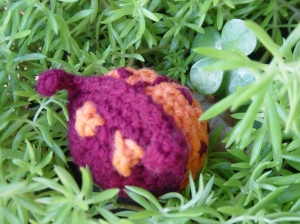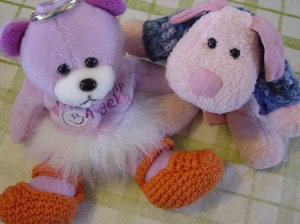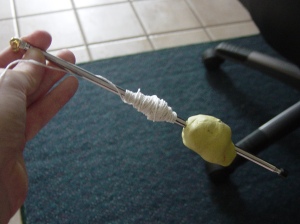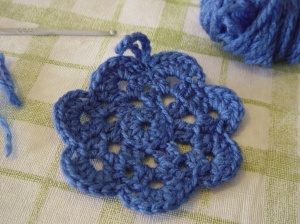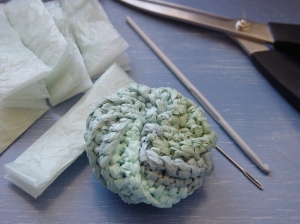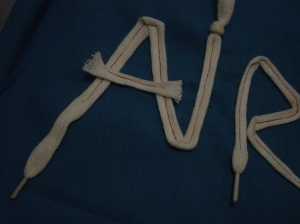I spent the entire day yesterday trying new small crochet projects (except for when I did a quick run to OS with the guild and some pugs for the weekly on my paladin tank, Yulara!) Recording this learning process will be good for me to look back over later, I'm sure!
 |
| four leaf clover |
|
To start me off, I had a go at this
four leaf clover. It looked pretty simple and I figured it could be used as a lucky charm fridge magnet. At the start of the day my purpose was to work on my crochet pattern reading skills, and this one went fine.
 |
| Irish Rose |
I was off to a good start, so I thought to try something a little more tricky with this
three layer flower. I followed the large flower pattern and discovered I didn't know what "bpsc" was. Turns out that's "back post single crochet" and I learned how to do it by watching the
youtube video.
 |
| a flat circle with scallop edges |
After these successes I thought I would try a little lady bug pattern I saw. It started off with the
magic ring, which was great to learn so I can make my start rings small if I wanted. But the lady bug was not working out at all, all the extra stitches formed a type of
hyperbolic shape and it reminded me of what I kept getting when I was trying the
beanie pattern at crochetspot. Then I remembered that there are
two crochet languages, English and American.
Crochet Australia has several charts on how stitches, yarns and hooks vary between the two. I also did some reading up on Wikipedia on
the history of crochet, which of course was very enlightening. All this made me wonder that that beanie pattern is American, so I went back and tried it again, this time doing English DC instead of SC, and guess what... it worked! But when the ball of yellow yarn I quickly grabbed to try this ran out I thought that I would put in a different colour. I fooled around with some wavy stitches, trying something I learnt in the morning from those little round patterns and made up a stitch (sl st sc hdc 3dc hdc sc). From
Smart Knitting-Crocheting I found some example of stitches and chose a
wavy fan pattern. The diagram was very easy to read and a good alternative than trying to read a pattern when I wasn't sure if DC =/= SC !! But my initial row didn't match so I unwound it and did it again. I thought the pattern would simply continue the beanie, as it was up to the point where the rounds were no longer increasing, but that didn't happen. It doesn't quite lie flat either, but this is definately not a beanie. Serve me right for trying to put in fancy stitches! One day I'll get around to following
Rachel's beanie pattern to complete one, which now I know what I was doing wrong, I'm sure will work just fine. I'll keep this large flower thingy for another project I'm working on.
 |
| details of scalloped circle |
Another small project I had open to look at was a
dancing shells washcloth pattern at All Free Crafts. It didn't look too hard so I gave it a go, but my cotton is too thin. A fair few American patterns call for "weight worsted cotton" and all I've been able to find out is the Australian equivilant is a 10ply which doesn't make sense to me. I think my mum will know, so I'll ask her next time I speak to her. A new stitch I learnt here was Dc2tog (double crochet two stitches together) and again, I learnt how to do it from a
youtube video. I actually unwound this little exercise to reuse the cotton.
 |
| blue square |
My mum gave me several balls of this lovely cotton so I was determined to do something with it and tried one of the many patterns she gave me. This square motif was easy enough and if I made 38 of them, I could make them into a top. I wonder if I'll get around to doing that one day .... lol! If I went to that much trouble, I would want to be sure to wear the thing!
 |
| crochet stitch sample |
|
I have lots of pictures of crochet hearts bookmarked to try, including some from the
Drops website. I didn't follow the pattern for this
Christmas heart decoration, I just looked at the picture and did it very quickly. I simply SC a 6 x 6 row square, then 5 trebles into the middle 3rd space, then ch st around the edge. Easy as! Lol, more crochet junk to work out what to do with ....
 |
| blue heart |
|
After I did the square heart, I set to work on making a toy shrug. Now that was a full day's worth of work! /satisfied sigh
 Although its a small thing, our single bunch of mondo grass is in gorgeous bloom at the moment, and it's something I think can only be truly appreciated close up! We also have a second clump of miniature mondo grass which is flowering as well. These plants are in the ground and form part of the garden of our rented property.
Although its a small thing, our single bunch of mondo grass is in gorgeous bloom at the moment, and it's something I think can only be truly appreciated close up! We also have a second clump of miniature mondo grass which is flowering as well. These plants are in the ground and form part of the garden of our rented property. Something else thats flowering at the moment is our eldest chilli plant, whom is also heavily laden with bright red fruit! It's quite pretty, imho. I caught David looking up the internet yesterday to find out what can you do with recycled pistacio nuts. Tucking into a couple of handfuls of the yummies must have prompted the idea. He found a forum thread discussing it, which was quite funny (sorry, no link). Apparently, you can even put a small piece of water soaked cotton wool in a shell, place a bean sprout seed on it and wait a couple of days. If you have a bunch of these, you can float them in a dish of water as a table centre piece. The display of tiny floating boats, each with its own mini-tree has, apparently, earnt the contributor much praise from guests. How ridiculous! Do you seriously have nothing better to do with those brain cells? How about devoting that intellectual capacity of yours to World Peace? One of the more practical suggestions was to use it as garden mulch, as they can have the appearance of sea shells. So that's what we did, and because the chilli was looking particularly spectactular at the moment, I decided he deserved it. And there is even more room in there for the rest of the shells... after we eat up the emerald-green nuggets of pistascio! (nom nom nom)
Something else thats flowering at the moment is our eldest chilli plant, whom is also heavily laden with bright red fruit! It's quite pretty, imho. I caught David looking up the internet yesterday to find out what can you do with recycled pistacio nuts. Tucking into a couple of handfuls of the yummies must have prompted the idea. He found a forum thread discussing it, which was quite funny (sorry, no link). Apparently, you can even put a small piece of water soaked cotton wool in a shell, place a bean sprout seed on it and wait a couple of days. If you have a bunch of these, you can float them in a dish of water as a table centre piece. The display of tiny floating boats, each with its own mini-tree has, apparently, earnt the contributor much praise from guests. How ridiculous! Do you seriously have nothing better to do with those brain cells? How about devoting that intellectual capacity of yours to World Peace? One of the more practical suggestions was to use it as garden mulch, as they can have the appearance of sea shells. So that's what we did, and because the chilli was looking particularly spectactular at the moment, I decided he deserved it. And there is even more room in there for the rest of the shells... after we eat up the emerald-green nuggets of pistascio! (nom nom nom) And I can't forget our garlic chives, who are very happy nowadays and currently in full flower. No seeds as yet though, from what I can see. I checked the internet for images of garlic chives seeds and they will be little black seeds. We are eagerly awaiting the arrival of these new babies so we can plant lots more chives for yumminess!
And I can't forget our garlic chives, who are very happy nowadays and currently in full flower. No seeds as yet though, from what I can see. I checked the internet for images of garlic chives seeds and they will be little black seeds. We are eagerly awaiting the arrival of these new babies so we can plant lots more chives for yumminess! Also, flowering at the moment is the native grevillea the landlord planted some months ago. Nice, and flushed with colour. How flourid.
Also, flowering at the moment is the native grevillea the landlord planted some months ago. Nice, and flushed with colour. How flourid.

